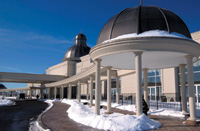Tamron's SP AF17-35mm F/2.8-4 Di LD Aspherical [IF] Zoom
A New Lens For Film And Digital SLRs
Because of the increasing popularity of digital SLR cameras, Tamron has undertaken an ambitious plan to develop a full range of Di (Digitally Integrated) lenses. Optimized for digital SLRs, the Di-series is just as desirable for use with 35mm cameras, as mentioned in my review of the first two Di lenses (November, 2003). As discussed in our sidebar about the technology for digital optimization, ultra-wide angle lenses particularly benefit from special optical designs in order to produce the best possible results with digital SLR cameras. That's why I was particularly interested in testing the third Di-series lens, the SP AF17-35mm f/2.8-4 Di LD Aspherical [IF] zoom. While shooting stock in Portland, along the Oregon coast, in Las Vegas, and throughout the Valley of Fire State Park (Nevada), I gave this zoom a full workout and was impressed with its many desirable characteristics. |
||||
Lens Characteristics
|
||||
Performance Evaluation |
||||
Final Assessment |
||||
This "Digitally Integrated"
zoom allowed me to make many images of professional caliber. But did it
produce better results than conventional lenses when used with the EOS
10D? As in my review of the previous two Tamron Di lenses, I cannot provide
a definitive conclusion. Frankly, that determination could only be made
with a fully equipped optical lab. It would require scientific comparison
testing with several similar ultra-wide angle zooms, with and without
the Di technology. Peter K. Burian, a free-lancer stock photographer and long-time "Shutterbug" and eDigitalPHOTO" contributor, is the author of a new book, "Mastering Digital Photography and Imaging" (Sybex, March 2004). Covering all aspects of the topic--the technology, equipment, and techniques--this book provides 300 pages of practical advice for photo enthusiasts. |
||||
The Value Of Digital
Optimization |







































